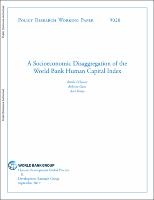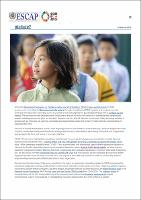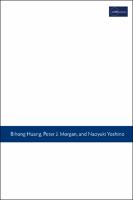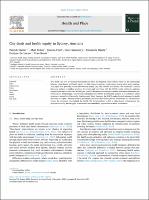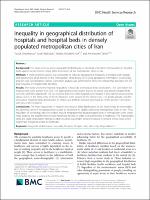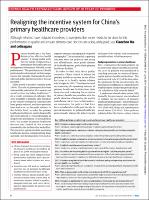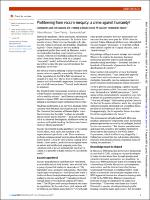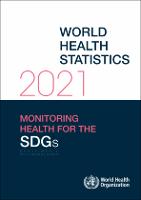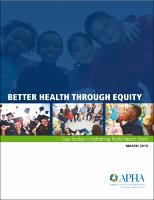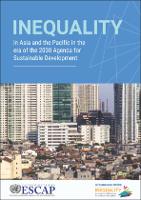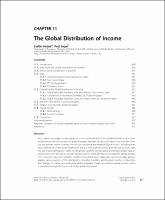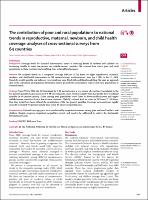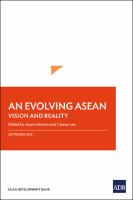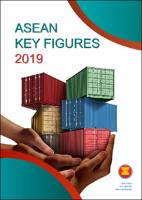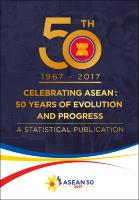1.03 Southeast Asia & China Context
Collections in this community
Recent Submissions
A Socioeconomic Disaggregation of the World Bank Human Capital Index
(World Bank, Washington, DC, 2019-09)
This paper documents inequality in health and education outcomes by constructing an index of human capital disaggregated by quintiles of socioeconomic status (SES) for a sample 51 mostly low- and middle-income countries. The index measures the expected future human capital of children born today, following the methodology of the World Bank Human Capital Index that was launched in October 2018. Within-country disparities in human capital outcomes across SES quintiles are large, accounting for roughly one-third of the total variation. On average,...
Are we REALLY getting everyone into the picture?
(2021-03-26)
Demystifying rising inequality in Asia
(Asian Development Bank Institute, 2019)
Income inequality is one of the most profound social, economic, and political challenges of our time. The gap between the rich and the poor has been regarded as a major concern for policy makers. This gap is at its highest level in decades for developed economies, while the inequality trend has been rising in many developing countries. In Asia, despite recent economic growth, income distribution has been worsening as well. This book contributes to the existing literature on inequality in Asia by overviewing the new trend of inequality in Asia a...
City deals and health equity in Sydney, Australia
(2022-01)
City Deals’ are new governance instruments for urban development. Vast evidence exists on the relationship between urban factors and health equity, but little research applies a health equity lens to urban policy-making. This paper does precisely that for the Western Sydney City Deal (WSCD) in Australia. We conducted a critical discourse analysis of publicly available documents and interviews with the WSCD’s main architects, applying insights from relevant theories. We find ‘pro-growth’ discourse to encourage economic investment dominates any r...
Costa Ricans Live Longer Than Us. What’s the Secret?
(2021-08-30)
Inequality in geographical distribution of hospitals and hospital beds in densely populated metropolitan cities of Iran
(BMC Health Serv Res, 2019-12)
Background: This study aims to assess geographical distribution of hospitals and extent of inequalities in hospital beds against socioeconomic status (SES) of residents of five metropolitan cities in Iran. Methods: A cross-sectional analysis was conducted to measure geographical inequality in hospital and hospital bed distributions of 68 districts in five metropolitan cities during 2016 using geographic information system (GIS), and Gini and Concentration indices. Correlation analysis was performed to show the relationship between the SES and i...
Realigning the incentive system for China’s primary healthcare providers
(BMJ, 2019-06-21)
Profiteering from vaccine inequity: a crime against humanity?
(BMJ, 2021-08-16)
World health statistics 2021: monitoring health for the SDGs, sustainable development goals
(World Health Organization, 2021)
WHO’s World health statistics report 2021 presents the latest data for more than 50 health-related indicators for the Sustainable Development Goals and WHO’s “Triple Billion” targets. It finds an overall increase in global life expectancy and healthy life expectancy at birth as a result of improvements in several communicable diseases, maternal, perinatal and nutritional conditions, noncommunicable diseases, injuries and their underlying determinants. Persisting inequalities also continue to impact population health in most, if not all, aspects...
Better Health Through Equity: Case Studies in Reframing Public Health Work
(American Public Health Association, 2015)
The efforts chronicled in this series of case studies are not only designed to improve health outcomes, they are also poised to save the country billions in health care spending. According to one study published in 2009, more than 30 percent of direct medical costs faced by African Americans, Hispanics and Asian Americans can be tied to health inequi- ties. Because of inequitable access to care, these populations are sicker when they do find a source of care and incur higher medical costs. That 30 percent translates to more than $230 billion ov...
Inequality in Asia and the Pacific in the era of the 2030 Agenda for Sustainable Development
(United Nations, 2018)
This publication reviews the region's inequality trends, challenges and achievements and identifies policy gaps across the three dimensions of inequality--inequality of outcome, inequality of opportunity and inequality of impact. It also discusses the potential impact of rapid and disruptive technological advances, such as machine learning, and puts forward a broad set of policy recommendations for reducing all forms of inequality for the effective implementation of the 2030 Agenda for Sustainable Development and its core tenant of "leaving no ...
The Global Distribution of Income
(Elsevier, 2015)
This chapter investigates recent advances in our understanding of the global distribution of income, and produces the first estimates of global inequality that take into account data on the incomes of the top one percent within countries. We discuss conceptual and methodological issues – including alternative definitions of the global distribution, the use of household surveys and national accounts data, the use of purchasing power parity exchange rates, and the incorporation of recently available data on top incomes from income tax records. We...
The contribution of poor and rural populations to national trends in reproductive, maternal, newborn, and child health coverage: analyses of cross-sectional surveys from 64 countries
(The Lancet Global Health, 2017)
Background Coverage levels for essential interventions aimed at reducing deaths of mothers and children are increasing steadily in most low-income and middle-income countries. We assessed how much poor and rural populations in these countries are benefiting from national-level progress.
An Evolving ASEAN: Vision and Reality
(Asian Development Bank, 2019)
The formation of ASEAN in 1967 was originally driven by political and security concerns. In the decades that followed, ASEAN’s scope evolved to include an ambitious and progressive economic agenda. In December 2015, the ASEAN Economic Community (AEC) was formally launched. Although AEC has enjoyed some notable successes, its vision of economic integration has yet to be fully realized. The publication reviews the evolution of ASEAN economic integration and assesses the major achievements. It also examines the challenges that have emerged during ...
ASEAN Key Figures 2019
(The ASEAN Secretariat, 2019)
Celebrating ASEAN: 50 years of evolution and progress
(The ASEAN Secretariat, 2017)
A statistical publication released on the occasion of the 50th anniversary of the signing of the Declaration establishing the Association of Southeast Asian Nations (ASEAN). Since its foundation in 1967, ASEAN has made extraordinary progress in preserving peace and security, promoting economic co-operation and integration as well as social development. This publication presents a collection of statistical indicators from ASEANstats’ databases, and highlights the main findings observed to showcase the evolution and progress of ASEAN over the pas...
ASEAN Economic Progress 1967-2017 (leaflet)
(The ASEAN Secretariat, 2017)
ASEAN Community Progress Monitoring System 2017
(The ASEAN Secretariat, 2017)
ASEAN Social Progress 1967-2017(Leaflet)
(The ASEAN Secretariat, 2017)

